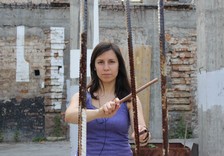
Maja Bosnić (1985, Serbia) is composer of contemporary conceptual music. She is drawn to impossible missions, absurd solutions, limited material, playfulness, uncertain outcomes, treating instruments as ready-made objects of expression and treating real life objects as music instruments. Her first composition lessons took place at the Irish Composition Summer School in Limerick and the Festival of Young Artists in Bayreuth in 2003. One year later, her official composition studies began with prof. Milan Mihajlović and then continued with prof. Roger Redgate at the Goldsmiths University in London, where she received her PhD diploma in 2015. Having been selected for numerous workshops and master-classes, she had the opportunity to work with many great composers, such as: Simon Steen-Andersen, Chaya Czernowin, James Clarke, Ian Wilson, Nicola LeFanu, Martin O’Leary and Kevin O’Connell. In 2010, in Bel-grade, she founded Zabuna – organization that works towards stimulating production and development of contemporary experimental music and orga-nized various concerts and seminars. Her works Zabuna on Stage were per-formed throughout Europe.
Cavitation . “Cavitation – formation of vapor bubbles within a liquid at low-pressure regions that occur in places where the liquid has been accelerated to high velocities, as in the operation of centrifugal pumps, water turbines, and marine propellers. Cavitation is undesirable because it produces extensive erosion of the rotating blades, additional noise from the resultant knocking and vibrations, and a significant reduction of efficiency be-cause it distorts the flow pattern. The cavities form when the of the liquid has been reduced to its vapor pressure; they expand as the pressure is further re-duced along with the flow and suddenly collapse when they reach regions of higher pressure.” (Encyclopedia Britannica)
In order to present the process of cavitation with music, the ensemble is unified in several sound-masses of different textures. Sections impersonate still water, noises of turbines and engines, appearance of bubbles, atmosphere inside a bubble, the air and the membrane, imploding of the bubble under the pressure of water, returning to turbines and motor engines, as well as their gradual falling apart due to the damage caused by cavitation.


